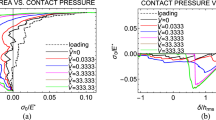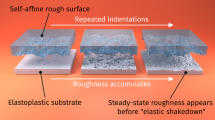Abstract
A quasistatic homogenized projection is made to characterize the effective cohesive zone behavior for rough-surface adhesion. In the context of the homogenized projection, the traction versus separation relation for the homogenized cohesive zone (HCZ) of a rough interface can be highly oscillatory due to instabilities during microscopic adhesion and decohesion processes. The instabilities are found to occur not only individually but also collectively among the adhesive micro-asperity contacts, leading to extensive energy dissipation. Based on the behaviors of the HCZ relations, a framework for describing instability-induced energy dissipation in rough-surface adhesion is proposed to elucidate the effect of roughness on apparent interface adhesion. Two non-dimensional parameters, α related to roughness morphology and n related to flaw distribution, are identified to be most crucial for controlling the energy dissipation. For an interface with a shallow roughness and a strong intrinsic adhesive strength, the interface adhesion can be stronger if we make it rougher (reducing α) or lower its flaw density (increasing n). The HCZ projection method can be potentially extended and employed to bridge the apparent adhesion from intrinsic adhesion properties for engineering surfaces with multi-scale shallow roughness.
Similar content being viewed by others
References
Adams, R.D., Comyn, J. and Wake, W.C., Structural Adhesive Joints in Engineering (2nd Edition). London: Chapman & Hall, 1997.
Maboudian, R. and Howe, R.T., Critical review: adhesion in surface micromechanical structures. The Journal of Vacuum Science and Technology B, 1997, 15(1): 1–20.
Hjortso, M.A. and Roos, J.W., Cell Adhesion: Fundamentals and Biotechnological Applications. Boca Raton, FL: CRC Press, 1994.
Gumbiner, B.M., Cell adhesion: the molecular basis of tissue architecture and morphogenesis. Cell, 1996, 84: 345–357.
Lane, M., Interface fracture. Annual Review of Materials Research, 2003, 33: 29–54.
Zhao, Y.-P., Wang, L.S. and Yu, T.X., Mechanics of adhesion in MEMS — A review. Journal of Adhesion Science and Technology, 2003, 17(4): 519–546.
Buckley, C.D., Rainger, G.E., Bradfield, P.F., Nash, G.B. and Simmons, D.L., Cell adhesion: more than just glue (review). Molecular Membrane Biology, 1998, 15: 167–176.
Israelachvili, J.N., Intermolecular and Surface Forces. (2nd Edition). London: Academic Press, 1992.
Leckband, D. and Israelachvili, J.N., Intermolecular forces in biology. Quarterly Review of Biophysics, 2001, 34(2): 105–267.
Persson, B.N.J., Contact mechanics for randomly rough surfaces. Surface Science Reports, 2006, 61: 201–227.
Persson, B.N.J., Adhesion between an elastic body and a randomly rough hard surface. The European Physical Journal E, 2002, 8: 385–401.
Brown, H.R., The adhesion between polymers. Annual Review of Materials Science, 1991, 21: 463–489.
Evans, A.G., Hutchinson, J.W. and Wei, Y., Interface adhesion: effects of plasticity and segregation. Acta Materialia, 1999, 47(15–16): 4093–4113.
Barenblatt, G.I., The mathematical theory of equilibrium cracks in brittle fracture. Advances in Applied Mechanics, 1962, 7: 55–129.
Needleman, A., A continuum model for void nucleation by inclusion debonding. Journal of Applied Mechanics, 1987, 54(3): 525–531.
Camacho, G.T. and Ortiz, M., Computational modeling of impact damage in brittle materials. International Journal of Solids and Structures, 1996, 33(20–22): 2899–2938.
Xia, S., Qi, Y., Perry, T. and Kim, K.-S., Strength characterization of Al/Si interfaces: A hybrid method of nanoindentation and finite element analysis. Acta Materialia, 2009, 57(3): 695–707.
da Silva, K.D., Beltz, G.E. and Machova, A., Tension-shear coupling in slip and decohesion of iron crystals. Scripta Materialia, 2003, 49: 1163–1167.
Cleri, F., Phillpot, S.R., Wolf, D. and Yip, S., Atomistic simulations of materials fracture and the link between atomic and continuum length scales. Journal of the American Ceramic Society, 1998, 81(3): 501–516.
Sansoz, F. and Molinari, J.F., Incidence of atom shuffling on the shear and decohesion behavior of a symmetric tilt grain boundary in copper. Scripta Materialia, 2004, 50: 1283–1288.
Choi, S.T. and Kim, K.-S., Nanoscale planar field projections of atomic decohesion and slip in crystalline solids. Part I. A crack-tip cohesive zone. Philosophical Magazine, 2007, 87(12): 1889–1919.
Hong, S. and Kim, K.-S., Extraction of cohesive-zone laws from elastic far-fields of a cohesive crack tip: a field projection method. Journal of Mechanics of Physics of Solids, 2003, 51: 1267–1286.
Kendall, K., Molecular Adhesion and Its Applications: The Sticky Universe. Berlin, Germany: Springer, 2001.
Hui, C.Y., Lin, Y.Y., Baney, J.M. and Kramer, E.J., The mechanics of contact and adhesion of periodically rough surfaces. Journal of Polymer Science: Part B: Polymer Physics, 2001, 39: 1195–1214.
Komvopoulos, K., Surface engineering and microtribology for microelectromechanical systems. Wear, 1996, 200: 305–327.
Fuller, K.N.G. and Tabor, D., The effect of surface roughness on the adhesion of elastic solids. Proceeding of the Royal Society of London A, 1975, 345: 327–342.
Quon, R.A., Knarr, R.F. and Vanderlick, T.K., Measurement of the deformation and adhesion of rough solids in contact. The Journal of Physical Chemistry B, 2006, 103: 5320–5327.
Benz, M., Rosenberg, K.J., Kramer, E.J. and Israelachvili, J.N., The deformation and adhesion of randomly rough and patterned surfaces. The Journal of Physical Chemistry B, 2006, 110(24): 11884–11893.
Drelich, J., Adhesion forces measured between particles and substrates with nano-roughness. Minerals and Metallurgical Processing, 2006, 23: 226–232.
Bhushan, B., Contact mechanics of rough surfaces in tribology: multiple asperity contact. Tribology Letters, 1998, 4: 1–35.
Briggs, G.A.D. and Briscoe, B.J., The effect of surface topography on the adhesion of elastic solids. Journal of Physics D: Applied Physics, 1977, 10: 2453–2466.
Fuller, K.N.G. and Roberts, A.D., Rubber rolling on rough surfaces. Journal of Physics D: Applied Physics, 1981, 14: 221–239.
Kim, H.-C. and Russell, T.P., Contact of elastic solids with rough surfaces. Journal of Polymer Science: Part B: Polymer Physics, 2001, 39: 1848–1854.
Carbone, G., Mangialardi, L. and Persson, B.N.J., Adhesion between a thin elastic plate and a hard randomly rough substrate. Physical Review B, 2004, 70: 125407.
Verneuil, E., Ladoux, B., Buguin, A. and Silberzan, P., Adhesion on microstructured surfaces. The Journal of Adhesion, 2007, 83: 449–472.
Buzio, R. and Valbusa, U., Interfacial stiffness and adhesion of randomly rough contacts probed by elastomer colloidal AFM probes. Journal of Physics: Condensed Matter, 2008, 20: 354014.
Li, Q. and Kim, K.-S., Micromechanics of friction: effects of nanometre-scale roughness. Proceedings of the Royal Society A, 2008, 464(2093), 1319–1343.
Bowden, F.P. and Tabor, D., The Friction and Lubrication of Solids. Oxford, UK: Oxford University Press, 1954.
Johnson, K.L., Kendall, K. and Roberts, A.D., Surface energy and the contact of elastic solids. Proceedings of the Royal Society A, 1971, 324: 301–313.
Johnson, K.L., The adhesion of two elastic bodies with slightly wavy surfaces. International Journal of Solids and Structures, 1995, 32: 423–430.
Westergard, H.M., Bearing pressures and cracks. Journal of Applied Mechanics, 1939, 6: 49–53.
Tada, H., Paris, P.C. and Irwin, G.R., The Stress Analysis of Cracks Handbook (2nd Edition), St Louis, MO: Paris Productions, 1985.
Ndiaye, I., Maslouhi, A. and Denault, J., Characterization of interfacial properties of composite materials by acoustic emission. Polymer Composites, 2000, 21(4): 595–604.
Yao, H. and Gao, H., Mechanics of robust and releasable adhesion in biology: Bottom-up designed hierarchical structures of gecko. Journal of the Mechanics and Physics of Solids, 2006, 54: 1120–1146.
Cardy, J., Scaling and Renormalization in Statistical Physics. Cambridge: Cambridge University Press, 1996.
Author information
Authors and Affiliations
Corresponding author
Additional information
Project supported in part by the Nano and Bio Mechanics Program, under award CMS-0511961, and in part by the MRSEC Program, under award DMR-0520651, of the National Science Foundation.
Rights and permissions
About this article
Cite this article
Li, Q., Kim, KS. Micromechanics of Rough Surface Adhesion: A Homogenized Projection Method. Acta Mech. Solida Sin. 22, 377–390 (2009). https://doi.org/10.1016/S0894-9166(09)60288-3
Received:
Revised:
Published:
Issue Date:
DOI: https://doi.org/10.1016/S0894-9166(09)60288-3




